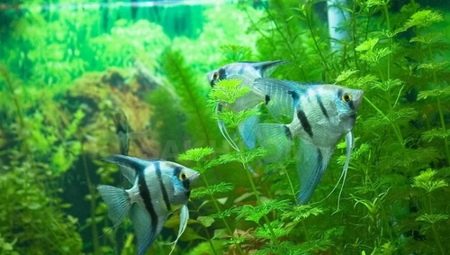The aquarium not only “refreshes” and improves the appearance of the interior, but also creates a relaxing atmosphere. At home, you can keep a lot of underwater inhabitants. The article will take a closer look at blue scalar.
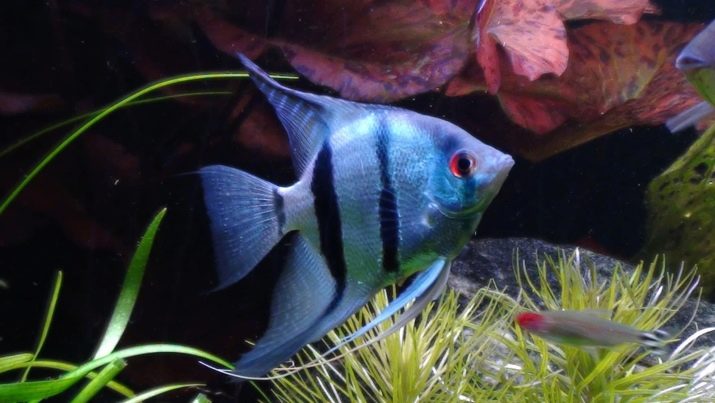
Content
If you intend to purchase this species, know that fish need a spacious aquarium. The minimum volume is 150 liters. Under such conditions, several pairs of fish can be kept. If the size of the aquarium is not large enough, adult individuals begin the struggle for territory. Experts recommend choosing an elongated fish house. Also pay attention to tall models.
To make the fish feel comfortable, the optimal hardness of the water should be maintained. The best indicator is 5-20 ° dGH. Acidity - pH 6.5-7.8.
Ideal temperatures range from 24 to 29 degrees Celsius. The average value is considered the most profitable. It is also necessary to install a high-quality and efficient filtration system and an air supply unit.
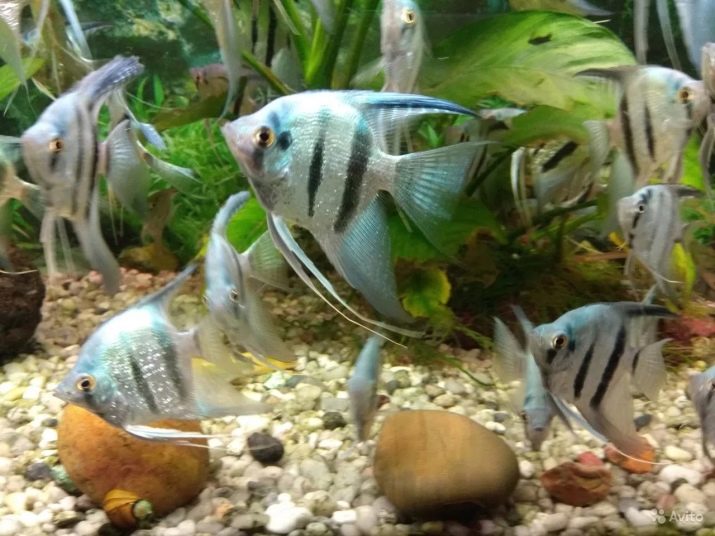
Must follow change water periodically. This process takes place according to the following scheme - 1 / 4-1 / 3 of the volume once a week. The work is carried out with parallel siphoning of the soil layer. Raw tap water cannot be used. Impurities in the fluid that comes from the water supply negatively affect the well-being of the scalar. Destruction of fins is possible.
In the period from spring to autumn, it is recommended to reduce the amount of changeable water if possible. Tap water should be treated with bacteria with special conditioners.
Angelfish feel great in small flocks. It is advisable to keep 4-6 individuals in one aquarium. As neighbors you need to choose a non-conflict inhabitants, with a calm character. They should also be the same size as scalars.
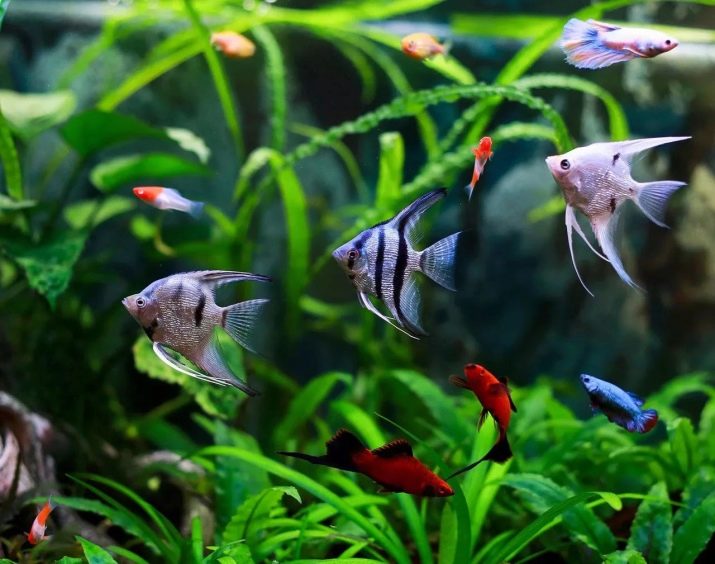
Breeding
To breed blue angelfish at home, you should take a couple of fish and transplant them into a separate aquarium. It is desirable that the water temperature is 28 degrees Celsius. Chemical indicators are not so important however, it is recommended to use a liquid that has been infused for at least 3 days. In some cases, fish can spawn in a common aquarium.
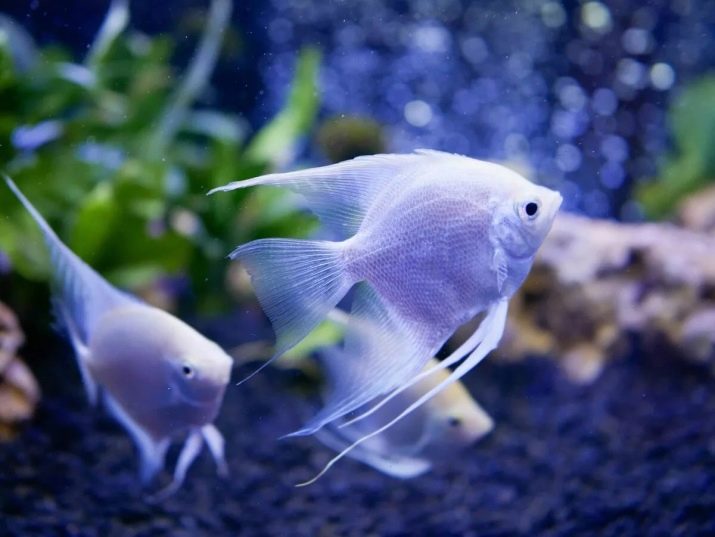
There are several ways to stimulate reproduction. The most common is a change in part of the water, as well as an increase in the temperature of the liquid.
Various living plants are used as a substrate for spawning. Some aquarists prefer to use pieces of a green plastic bottle or glass of the same color. If you plan to transfer the leaf with caviar to a separate container, then one leaf will be quite enough. In the case when the eggs are left in the aquarium with the fish, you need to place several plants. Angelfish will often transfer fry from one place to another. This is done to prevent disease.
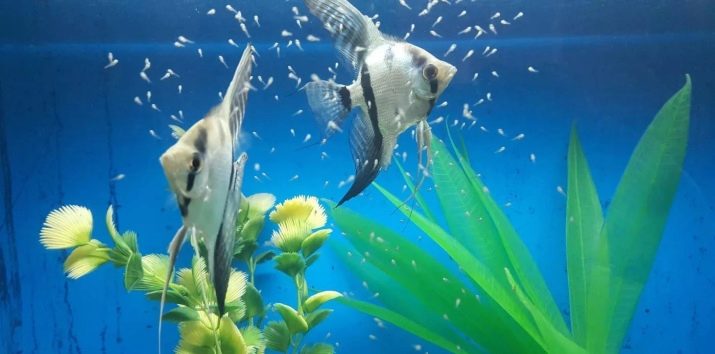
It is necessary to properly design an aquarium for reproduction, so that the fish are comfortable.
The distance between plants to the surface of the water should be at least 75% of the body size of the fish. Before spawning, the fish clean the substrate of particles of contamination. Only after the spawning process begins.
The average productivity of an adult female is from 400 to 500 eggs. The maximum number is 1000 units. The incubation period lasts 48 hours. During the development of eggs, caring parents create an increased flow of water around them, using their fins.
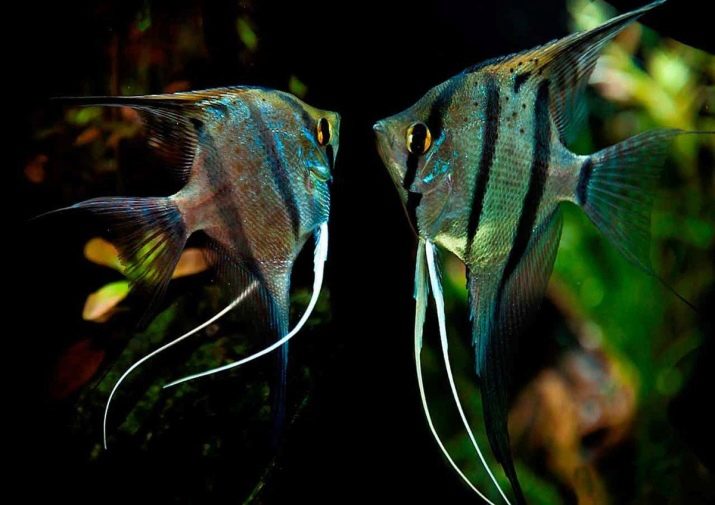
During this period, it is necessary to observe silence in the room and take care of the fish.
Any stress can negatively affect the behavior of scalars. Strong fright can lead to the fact that parents will eat the future offspring. When larvae emerge from small eggs, the fish carefully transfer them to a new place.
In order for the fry to appear from them, you need to wait a week. Now the fish can swim and eat on their own. The process of growth and maturation is very fast. 7-8 months will be enough for the fish to become sexually mature. At the beginning of its development, scalars are very sensitive to water quality. It is recommended that you often clean the soil in the aquarium to maintain cleanliness.
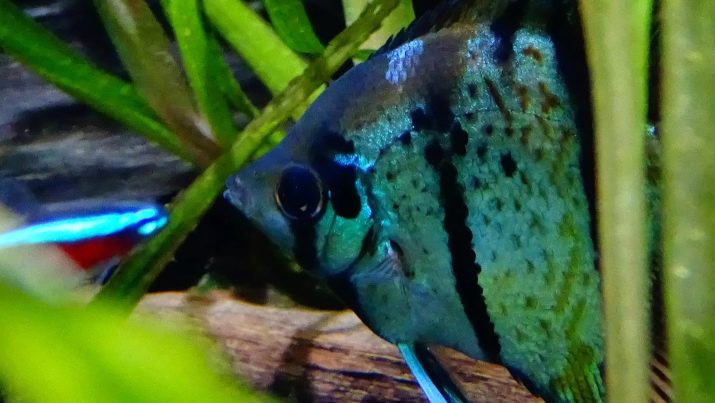
Feeding
The following options are suitable for feeding small fish:
- nematodes (thoroughly washed);
- daphnia,
- Nauplii Artemia.
It is dangerous to constantly use unnatural food, this can cause the death of fry.
Properly selected food is the key to excellent health and a wonderful appearance of fish. As food for this species of underwater inhabitants, bloodworms and small insect larvae are great. You can find this product in a zoological store without any problems. You can also feed with a tubule, pre-washed for 7 days.
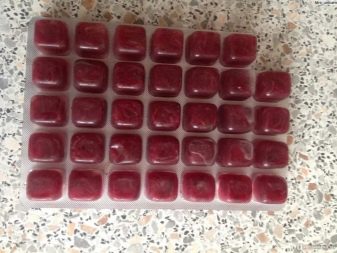
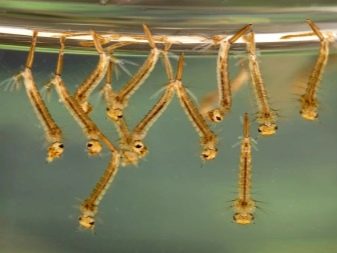
The last type of food should be carefully prepared before use. He needs intensive washing.
The water in which the worms are located should ultimately be transparent. In addition to the above options, blue fish love frozen or live zooplankton. This product is on sale in a wide range. Do not worry about the fact that fish will not consume factory products. If you pick up high-quality food made according to high quality standards, scalars will not refuse treats.
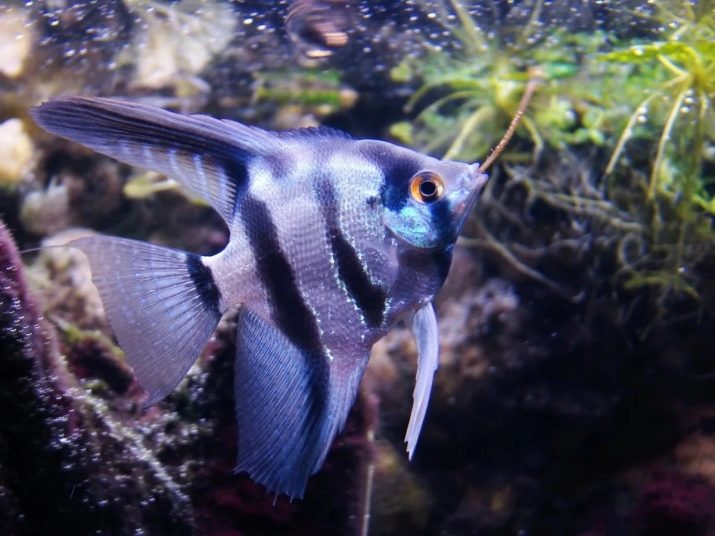
Varieties
There are several types of blue scalars. Each instance has special external characteristics.
Blue Zebra
This species characterizes the presence of dark blue stripes in the amount of three pieces. Elements of dark blue color stand out clearly against a light blue background.Vertical stripes are located at the same distance from each other. Such fish will certainly become a decoration in the aquarium.
This variety is in great demand among aquarists.
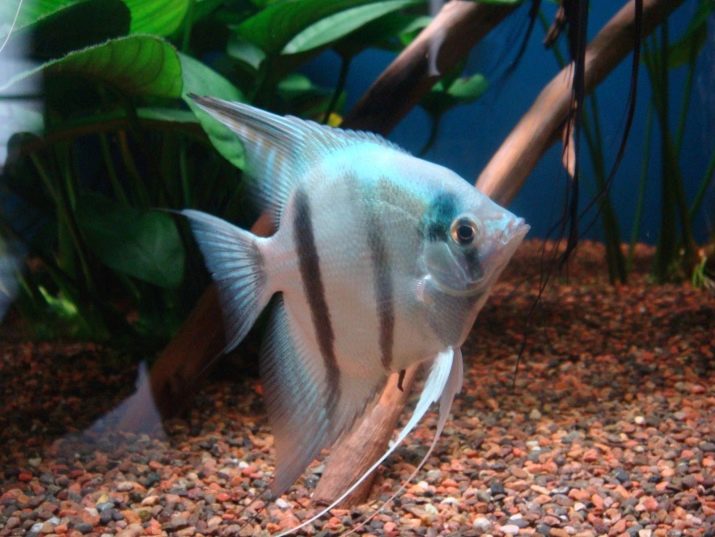
"Blue Diamond"
This breeding form was developed using a targeted mutation process. Also this type has the name - “crumpled foil”. The body of the fish is covered with embossed scales. Coloring - light blue with silver tint. Near the tail, as well as at the caudal fin there is a black strip.
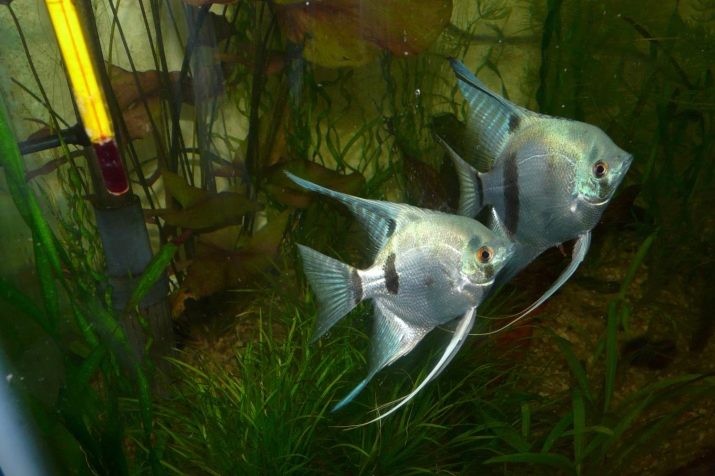
Blue Pearl
Experienced aquarists consider this breed one of the most expressive. The body of the scalar is covered with small scales of saturated pearl color. When the rays of light hit the fish, they create bright and expressive overflows.
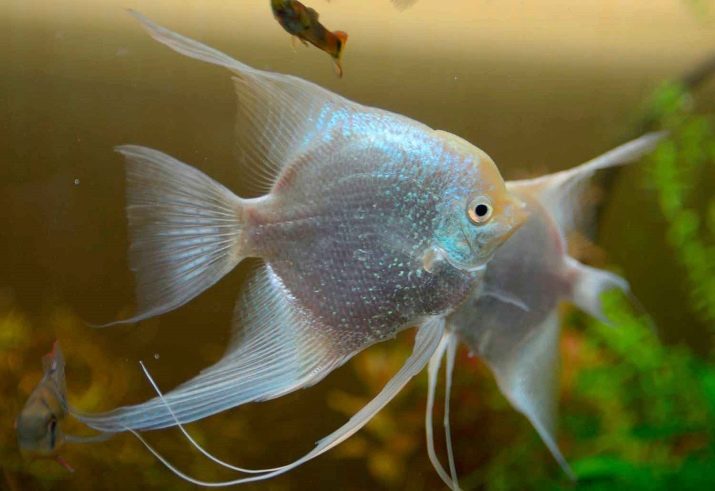
"Blue Angel"
Like many species of aquarium fish, this one was specially bred as a result of many crosses. This is a peaceful fish with a calm character. Angelfish is painted in a delicate and at the same time expressive blue color with small interspersed overflows.

Blue Platinum
The fish with an amazing name has the lightest colors. Color - smoky, white with a light blue and pinkish tint. The color is uniform throughout the body, including fins.
This species is noticeable against the background with a special color of scales that stands out among other specimens.
In nature, the size of scalars can reach up to 20 centimeters. At home, the maximum dimensions are about 10 centimeters, but even such indicators in artificial conditions is very difficult to achieve.
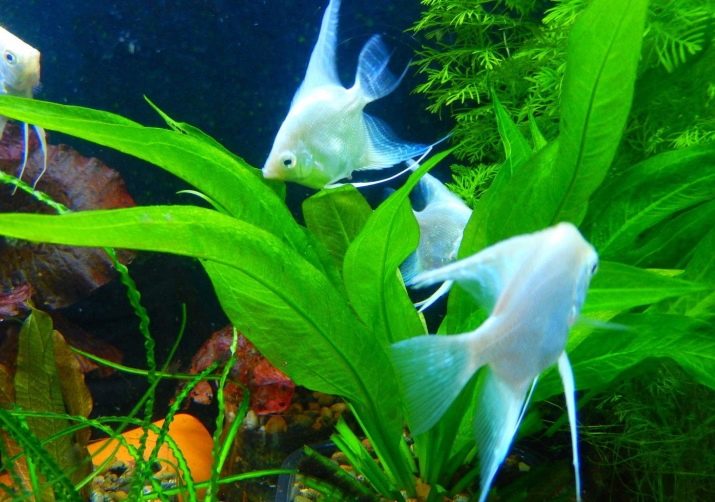
In the next video, you can watch the two-month-old scalars of the Blue Angel variety.
